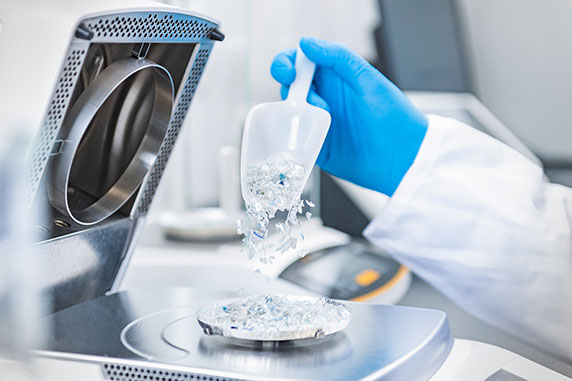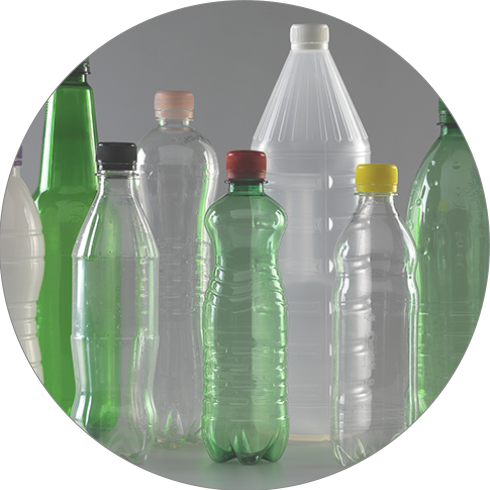The plastic polyethylene terephthalate, or PET for short, celebrated its 80th birthday in 2021. Originally developed as an alternative for the production of textile fibres, the material is now one of the most important in the packaging and textile industries. PET has become known around the world through its use in the production of beverage bottles.
The first PET bottles appeared on the market on a large scale in the USA in the early 1970s. Soft drink manufacturers in particular have used the material to bottle their products, heralding the triumphant advance of the recyclable material. In contrast to conventional glass bottles, PET offers break resistance, lower weight and easier handling.
Germany-wide introduction by Coca-Cola of the first reusable PET bottle in collaboration with manufacturer Schmalbach-Lubeca AG and resulting criticism from the established packaging industry.
Founding of Forum PET by seven founder members – including the two above-named companies – with the aim of explaining the advantages of PET.
Reusable PET bottle firmly established on the market – suppliers of mineral water already using it to bottle their products.
First life cycle assessment of beverage packaging on behalf of the Federal Environment Agency confirms the advantages of reusable PET bottles put forward by Forum PET.
Initial market penetration by one-way PET bottle and renewed criticism of the new packaging type.
Integration of Forum PET into the IK Industrievereinigung Kunst-stoffverpackungen e.V. followed by expansion of membership along the value creation chain (PET manufacturers, bottling companies, closure manufacturers, PET-recycling companies and machine manufacturers). Markets for recycled PET, e.g. PET films and PET bottles for household cleaning agents and cosmetics, also gain significance within Forum PET.
Introduction of compulsory deposits also on one-way PET bottles for beer, mineral water and carbonated soft drinks.
Thanks to reduced weight of one-way PET bottles, recycling, shorter transport routes and reduction of energy consumption during manufacturing, the sector succeeds in continuously improving the environmental properties of one-way PET bottles.
Life cycle assessment on behalf of Forum PET comparing various types of beverage packaging. Result: In this respect, the widely used 1.5-litre one-way PET bottle for carbonated water and soft drinks demonstrates no significant overall advantages or disadvantages in comparison with the reusable glass bottle.
Forum PET plays a crucial role in the founding of Forum PET Europe in Paris.
Beverage industry and Forum PET establish the RAL "Wertstoffkette PET-Getränkeverpackungen e.V." quality association for the purpose of agreeing minimum standards for the PET material cycle. The RAL Quality Mark stands for the highest quality requirements.
Today, Forum PET has around 30 member companies spanning the entire PET material chain, from packaging manufacturers through bottling companies down to recycling companies.
PET is the abbreviation for polyethylene terephthalate, a polymer that belongs to the category of polyesters. The starting products of PET are mostly derived from crude oil or natural gas. To manufacture PET, these substances are combined to form long chains of molecules. In this process, the starting molecules consisting exclusively of carbon, oxygen and hydrogen are attached to one another by so-called ester bonds. This is where the name “poly” (many) and “ester” (for the type of bond) comes from. At the end of the polycondensation, you obtain a viscous molten mass, which is pressed into thin threads, cooled and reduced to granules.

As thermoplastic resin, PET can be moulded when exposed to heat and formed into virtually any conceivable shape.
The large bottles are blow-moulded from small PET preforms. This process is usually carried out at the bottling company. As the preforms are so small and easy to handle, transporting them is easy.

How is PET actually made? Production takes place in two stages. The PET pellets are first melted at a temperature of about 280°C. In the next step they are processed into the preform. The preforms offer several advantages. First, they are already have a thread on them. Second, being small and handy, they can be easily transported. The preforms are heated again to about 120 °C shortly before the bottles are filled. This allows them to be expanded into the final bottle shape.
This step is performed by the bottlers themselves for non-returnable PET bottles. The situation is different for returnable PET bottles: They reach the bottlers as already formed bottles. The “stretch blow-moulding process” serves to partially crystallise the PET material. If bottles are made with such semi-crystalline elements, they have a slightly less transparent appearance – but they are more stable and less permeable to oxygen and carbon dioxide. Completely crystalline PET is found in microwave trays, for example, and is completely opaque.


PET as a packaging material
Colourless, almost unbreakable, transparent and easy to recycle – that’s the polymer PET. This makes it the ideal packaging material for beverages.
Unlike cans, consumers can immediately recognise the beverage in PET bottles. While glass can break, PET is robust – and a lot lighter. A disposable PET bottle, for example, weighs only a mere 20 to 30 g. PET returnable bottles are somewhat heavier due to the slightly thicker bottle wall and the more robust base. Nevertheless, they are significantly lighter than glass bottles, which weigh about 600 g. This means that transporting PET bottles is cheaper. Non-returnable bottles go to the bottling plants as preforms. It is only there that the actual bottles are created. The advantage is that the smaller preforms can be transported more cheaply and climate neutrally manner.
Comparing the production of a 500 ml bottle made of plastic with that of a 500 ml container made of alternative materials shows that less greenhouse gases are emitted in the production of the plastic bottle. According to a Veolia study, glass bottles have the worst eco-balance.
The distribution of carbon dioxide emissions from plastic products shows that the greatest potential for savings lies in the production of materials, as 61 percent of greenhouse gases are emitted in this phase. Recycling, i.e. the use of recycled material, can greatly reduce carbon dioxide emissions from plastic articles. A 330 ml bottle with a small amount of rPET corresponds to about 196 to 330 grams of carbon dioxide over its entire life cycle. However, if a high proportion of recycled material is used, this figure drops to just 35-85 grams. The lighter the bottle, the better for the environment. Plastic products offer ecological advantages over alternative packaging materials, particularly thanks to their low weight.
The difference to glass bottles is particularly striking. While a 500 ml glass bottle weighs around 260 grams on average, a PET container of the same size comes in at just under 13 grams.
